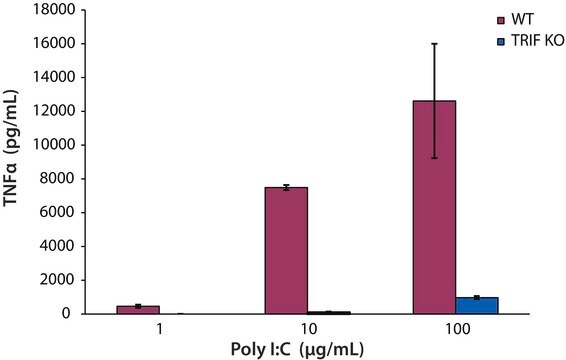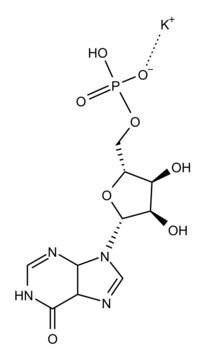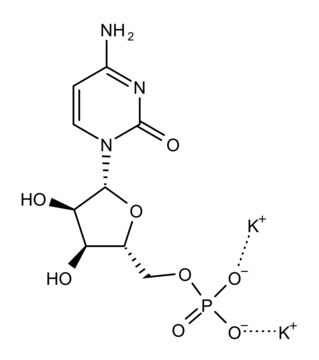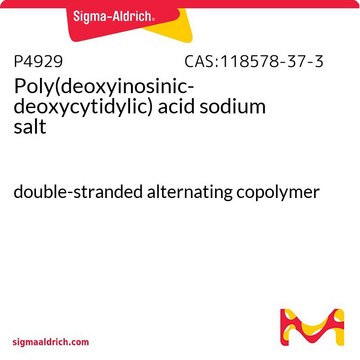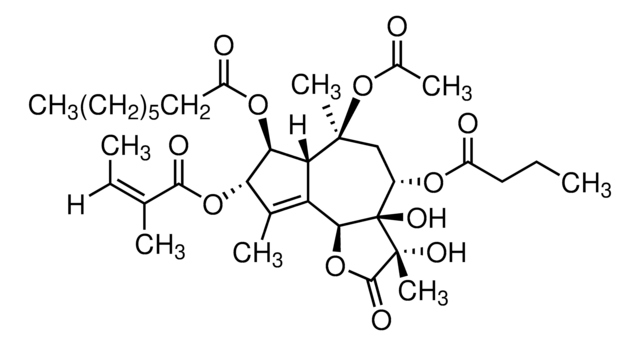P9582
Polyinosinic–polycytidylic acid potassium salt
with buffer salts, TLR ligand tested
Sinonimo/i:
Poly (I:C), Poly(I) • Poly(C)
Autenticatiper visualizzare i prezzi riservati alla tua organizzazione & contrattuali
About This Item
Prodotti consigliati
Livello qualitativo
Saggio
≥99% (less than 1% free nucleotides, TLC)
Stato
lyophilized powder
Composizione
Poly(I) • Poly(C), 10% (balance buffer salts as sodium chloride and sodium phosphate)
Condizioni di stoccaggio
desiccated
Temperatura di conservazione
−20°C
Cerchi prodotti simili? Visita Guida al confronto tra prodotti
Applicazioni
TLR3 recognizes double-stranded RNA and is a major effector of the immune response against viral pathogens. Polyinosinic–polycytidylic acid (Poly(I) • Poly(C)) is a double-stranded homopolymer used as a model RNA to study cell signaling at the level of TLR3. Poly(IC) is a TRIF-dependent toll-like receptor-3 (TLR3) ligand.
Azioni biochim/fisiol
Transfection of Poly (I:C) into NIT-1 cells has been used as a model of intracellular dsRNA-induced β cell apoptosis. Eighteen hours post transfection, 45% of the cells were apoptotic with an increase in NF-kB, p50/p65 nuclear translocation, and cleavage of caspases 3 and 8, as well as transcriptional induction of caspase 12, Fas, IL-15, and the TNF receptor-associated ligand (TRAIL). It has been suggested that Poly(I:C) is one of the most appropriate generators of stable mature dendritic cells (DC). These mature DC might generate in vivo effective immune responses after injection due to their ability to secrete bioactive IL-12 after CD40 ligation. Poly (I:C) was used as a potent adjuvant to enhance the specific anti-tumor immune responses against a peptide-based vaccine.
Confezionamento
Package size based on polynucleotide content
Altre note
Double-stranded homopolymer.
Nota sulla preparazione
The product requires ionic strength to maintain the double-strand structure. Reconstitution at ~10 mg/mL of water yields a polynucleotide in physiological phosphate buffered solution.
Codice della classe di stoccaggio
11 - Combustible Solids
Classe di pericolosità dell'acqua (WGK)
WGK 3
Punto d’infiammabilità (°F)
Not applicable
Punto d’infiammabilità (°C)
Not applicable
Dispositivi di protezione individuale
Eyeshields, Gloves, type N95 (US)
Scegli una delle versioni più recenti:
Possiedi già questo prodotto?
I documenti relativi ai prodotti acquistati recentemente sono disponibili nell’Archivio dei documenti.
I clienti hanno visto anche
Marie Anaïs Labouesse et al.
Epigenetics, 10(12), 1143-1155 (2015-11-18)
Maternal infection during pregnancy increases the risk of neurodevelopmental disorders in the offspring. In addition to its influence on other neuronal systems, this early-life environmental adversity has been shown to negatively affect cortical γ-aminobutyric acid (GABA) functions in adult life
Wei-Li Wu et al.
Brain, behavior, and immunity, 62, 11-23 (2016-11-14)
Epidemiological studies show that maternal immune activation (MIA) during pregnancy is a risk factor for autism. However, mechanisms for how MIA affects brain development and behaviors in offspring remain poorly described. To determine whether placental interleukin-6 (IL-6) signaling is required
Jun-Sang Sunwoo et al.
Annals of clinical and translational neurology, 5(10), 1264-1276 (2018-10-24)
Maternal immune activation (MIA) is associated with an increased risk of autism spectrum disorder (ASD) in offspring. Herein, we investigate the altered expression of microRNAs (miRNA), and that of their target genes, in the brains of MIA mouse offspring. To
Halime Kalkavan et al.
Nature communications, 8, 14447-14447 (2017-03-02)
Immune-mediated effector molecules can limit cancer growth, but lack of sustained immune activation in the tumour microenvironment restricts antitumour immunity. New therapeutic approaches that induce a strong and prolonged immune activation would represent a major immunotherapeutic advance. Here we show
William R Crum et al.
Brain, behavior, and immunity, 63, 50-59 (2016-12-13)
Genetic and environmental risk factors for psychiatric disorders are suggested to disrupt the trajectory of brain maturation during adolescence, leading to the development of psychopathology in adulthood. Rodent models are powerful tools to dissect the specific effects of such risk
Il team dei nostri ricercatori vanta grande esperienza in tutte le aree della ricerca quali Life Science, scienza dei materiali, sintesi chimica, cromatografia, discipline analitiche, ecc..
Contatta l'Assistenza Tecnica.